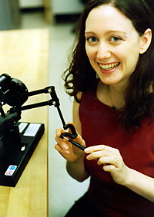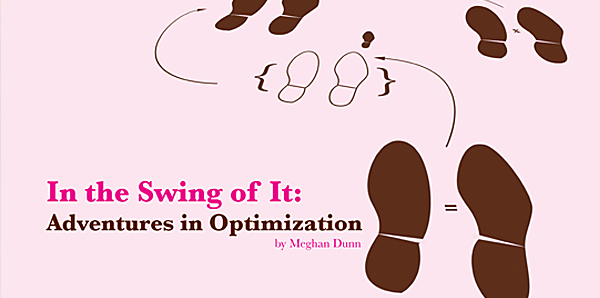LIDS alumna Sommer Gentry remembers being scolded in her high school math class for explaining a problem to another student. She smiles, recalling: “the teacher said, ‘If you want to teach math, go out in the hallway and have your own class.’ And so we ended up having a little mutiny, and we sat in the hallway, and I actually did teach a math class.” She pauses. “I feel bad about it now,” she says. “It was probably a bad day in my math teacher’s life.” Maybe so, but it was a good day for Sommer Gentry, her future students, and her research. And it represents the talent and drive that eventually brought Sommer to LIDS and now to her teaching position at the US Naval Academy.
Sommer’s research has been both unique and rooted in real-world problems, albeit quite different -- swing dancing and kidney donation, for instance. And how do these connect? For Sommer, each holds fascinating research possibilities and dovetails nicely with her work in optimization, not to mention her passion for teaching and her determination to make a difference.
Originally from Thousand Oaks, CA, Sommer earned her B.S. and M.S. at Stanford University before moving east to MIT in 1999. After finishing her Ph.D. work at LIDS in 2005, Sommer accepted a job as an assistant professor in the mathematics department at the US Naval Academy. She lives in Baltimore with her husband, swing dance partner and now research partner, Johns Hopkins surgeon Dorry Segev. Together, they work to incorporate mathematical tools into the kidney paired donation (KPD) system, hoping to increase the number of compatible donor-recipient matches in the United States.
All too often, a patient waiting for a kidney transplant may have a willing donor who is unsuitable because of blood type or tissue incompatibilities. Sommer’s research has an answer. In her scenario, this incompatible pair is matched with a second incompatible pair, ideally resulting in successful transplants for both patients. For example, if A is a willing but incompatible donor for B, and C is a willing but incompatible donor for D, A can give his kidney to D, and C can give hers to B. This way, donors who might not otherwise have volunteered to help a stranger have incentive: another stranger is helping their loved one. In other words, says Sommer, it’s “a win” for everyone. “We’re adding two donors to the net pool,” she says, “who wouldn’t have donated otherwise.”
Kidney paired donations like these have been performed at certain hospitals for several years, but Sommer points out, “there is no national system for paired donations.” According to the United Network for Organ Sharing, with whom Sommer and Dorry collaborate, there are currently about 70,000 people in the United States waiting for a kidney transplant. This makes Sommer’s research particularly pressing.
Here’s where Sommer’s optimization expertise enters the scenario. Currently, donor-recipient pairs are matched using a scheme called First-Accept Match, which locates and matches the first compatible pairs found. However, this scheme doesn’t take into consideration all pertinent factors, such as other compatible pairs in the area and the ease or difficulty of matching them. Sommer explains that some transplant candidates are “highly sensitized,” or very difficult to match, and that by haphazardly matching pairs as in First-Accept Match, these candidates might be missing out on compatible donors.
To utilize all matching possibilities, Sommer advocates for a scheme called Optimized Match, which would consider all pairs in the national registry and make decisions “so that the most people could get a transplant, overall.” By using what is called “a maximum weighted matching,” the transplant community could decide “which pairs should exchange” in order to maximize the number of total pairs matched. Each donor-recipient pair would be represented by a node on a graph, and every compatible exchange would be designated by a line, or edge, connecting those two nodes. An optimized match contributes to the greatest possible number of compatible matches overall.
It’s an attractive, mathematical solution, but its practical implementation doesn’t come easy. Sommer explains that Optimized Match allows for caveats: “‘I’d prefer to do this match because this donation helps a child’ or ‘This donation helps a person who is very hard to match’ or ‘This donation is good because it’s an exchange between patients in the same hospital,” and these considerations must be “translated into numbers.” This results in a complex pool of donors that surgeons and the transplant community must efficiently navigate.
To help bring Optimized Match to reality and attain her broader vision of “making optimization tools more accessible,” Sommer has reached further into her background. She’s using a tool called Inverse Optimization, the first topic she studied at LIDS. It would allow transplant surgeons to select their preferred matches from a list of candidates so mathematicians can convert those choices into “optimization parameters.” Sommer says, “if we do this several times, we’ll figure out what numbering scheme…will express their preferences” so these can be “codified into a system.”
It’s an exciting prospect. In an April 2005 paper published in the Journal of the American Medical Association, Sommer, Dorry, and co-authors concluded that a national organ sharing registry utilizing Optimized Match would yield “more transplants…than an extension of the currently used first-accept scheme to a national level” and that “even if only 7% of patients awaiting kidney transplantation participated…the health care system could save as much as $750 million.” These kinds of numbers drive Sommer’s research and bring it positive attention. Three important governmental rulings on KPD’s legality took place during 2007, bringing Sommer’s vision of a national registry closer to fruition. “I want to build something that changes the world,” she says. “I don’t want to write papers that sit on a shelf. I want to make a difference that I can see.”
In addition to this research and her teaching duties at the Naval Academy, Sommer somehow finds time for another passion: swing dancing. She and her husband Dorry (whom she met through dancing) teach the sport three nights a week with Charm City Swing, a Baltimore group they founded. As professional dancers, Sommer and Dorry have been honored nationally and internationally for their swing skills and take special pleasure in introducing non-dancers to the form. “It’s amazing how similar teaching dance is to teaching math,” she says. “In both cases, you have some students with a lot of anxiety about the subject.”
The connection between dance and math was the chief focus of Sommer’s Ph.D. research at LIDS, which looked at “the interactions between two people in a dancing couple.” An unusual topic for LIDS, Sommer’s work traversed the fields of communications and optimization. As she became simultaneously immersed in the world of swing dance and the world of LIDS, Sommer began to think of the hand contact between two dance partners as haptic signals, messages sent by touch. “Our sense of touch is not all that well-developed,” she says, “so it’s strange that people could execute such elaborate movements…with such a bad communications channel.” Intrigued, and encouraged by her LIDS advisor Eric Feron, Sommer decided to explore further. “LIDS professors trust students to follow their own instincts,” Sommer says, citing this freedom as her favorite part of the LIDS experience, which helped her “grow to be an independent researcher.” She misses that environment along with the Stata Center, laughing as she recounts her struggle to “lay out furniture in an elliptical office.”
For the moment, Sommer plans to stay put in her (non-elliptical) office at the US Naval Academy. “It’s a good, supportive department and my students are great,” she says. “I am very, very happy here.”




